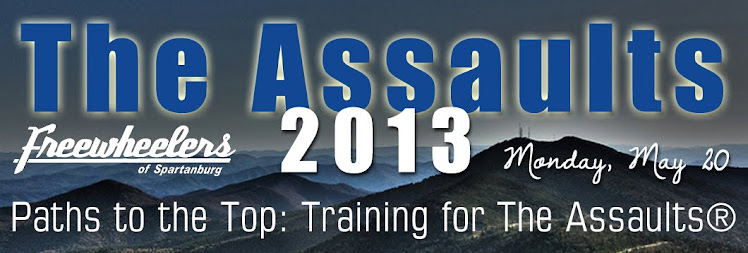As you know, the equipment you choose can have a big impact on your ride at Mt. Mitchell. The first thing you want to do (highlighted in my previous post) is to have reliable equipment. You can have the lightest bike in the world, but if it doesn’t make it to the finish then you won’t be able to finish the ride.
Mitchell is an odd event in that it combines two needs for equipment, aerodynamics for the ride to Marion and then lightweight from Marion to the top. If you are riding in the Marion ride, you should be focused more on equipment that has a little more aero advantage (or making your existing ride a little more aero). One way to easily do this is to have a snug fitting jersey. It may not seem like a loose jersey will have a big effect, but all that fabric catching the wind can add minutes to your time over the course of the ride.
A larger upgrade to a bike, and often considered the most beneficial part to upgrade, is the wheels. Carbon wheels are everywhere nowadays. It used to be that you would just see the Pros racing with carbon wheels, everybody else could just dream about them. Now you’ll see people putting nice carbon wheels on their bike just to go ride the bike path (ok, it’s not so common around here, but down in South Florida, everybody trains on A1A with really nice carbon wheels). The benefit to carbon wheels is the material is much lighter than alloy and so you can have a deeper rim without adding weight to your bike.
For Mitchell, you have that added 25 miles of climbing at the end to contend with. This is where you want to lighten your bike (and maybe your body too) to make it easier to climb. With that being said, last year I used a set of 20mm tubular carbon wheels. They were extremely lightweight at just over 1,000 grams, and they were great on the climb. But for the first 75 miles I felt like I had to pedal more often, the rims were so light that they just didn’t carry the inertia very well. By the time the climb started I had expended a bunch of unnecessary energy that could have been saved. This year I will be going with a wheelset that will be a little more aerodynamic to help conserve energy for the first 75 miles. True, it will be a very slight disadvantage on the climb, but if I arrive at the climb having expended less energy overall I’ll have a better ride.
For wheels you can choose to go the tubular or clincher route. There are hundreds of pages of information about the difference between tubular tires and clincher tires out there. Opinions on which is the better choice seem to contradict themselves based upon who you talk to. Some of the facts are:
- A tubular wheelset will overall be lighter, although some of the carbon clinchers are getting to be very light nowadays.
- It is much easier to install and change out a tube vs. having to glue on a whole new tire.
- Repairing a flat tire with a clincher is something that can be done during the event.
- Tubulars do tend to flat less
For myself, I usually tend to race only on tubular wheels and train on clinchers. I like the lighter weight of a tubular wheelset and the feel of a nice tubular tire. I am willing to take the risk of not flatting during the event even though for Mitchell we won’t have a wheel car behind us like in races. As I stated before the 20mm tubular wheelset was great for climbing last year, but not great for the flat section leading to Marion. This year I would be riding a little deeper of a wheelset (probably a 38mm tubular or 50mm tubular). Of course, it is nice to be the owner of a company that makes wheels. . .so I will probably be running a prototype of a new wheelset we are working on.
- Boyd Johnson
http://BoydCycling.com

What about gearing? I am thinking about a compact with a 11X28 but curious as to what others are doing.
ReplyDeleteOh ... if you need someone else to test ride those wheels .....
For myself I will be using a standard crankset up front with an 11-25 cassette on the back. The nice thing about Mitchell is that none of the hills are overly steep (no prolonged periods of over 10%). This means that you may not need to go to extreme gearing to finish the ride.
ReplyDeleteThe more range in gearing you have for your cassette means that for every shift you make it will have a larger jump. This can make it hard to find the perfect gearing for when you are climbing.
And I only have one set of the prototypes built up, but there are tons of regular carbons available.
11-25? Nice to be strong! :-)
ReplyDelete